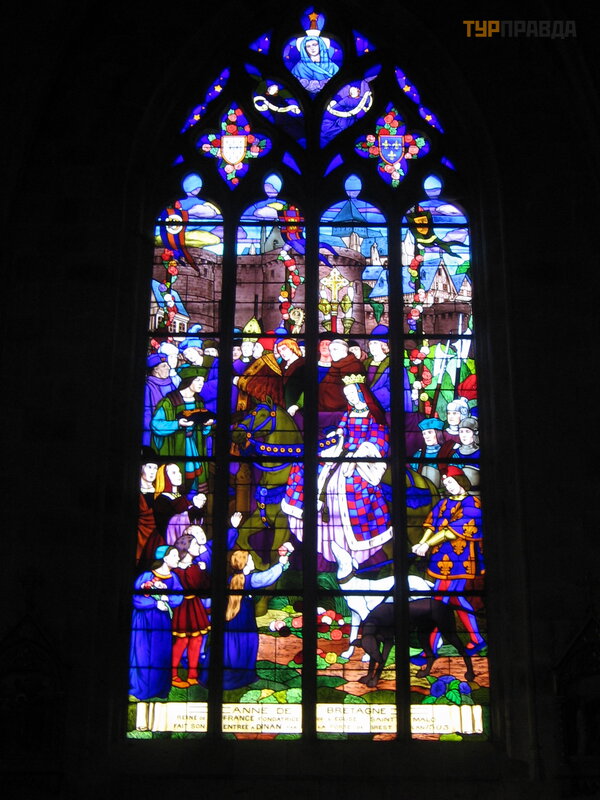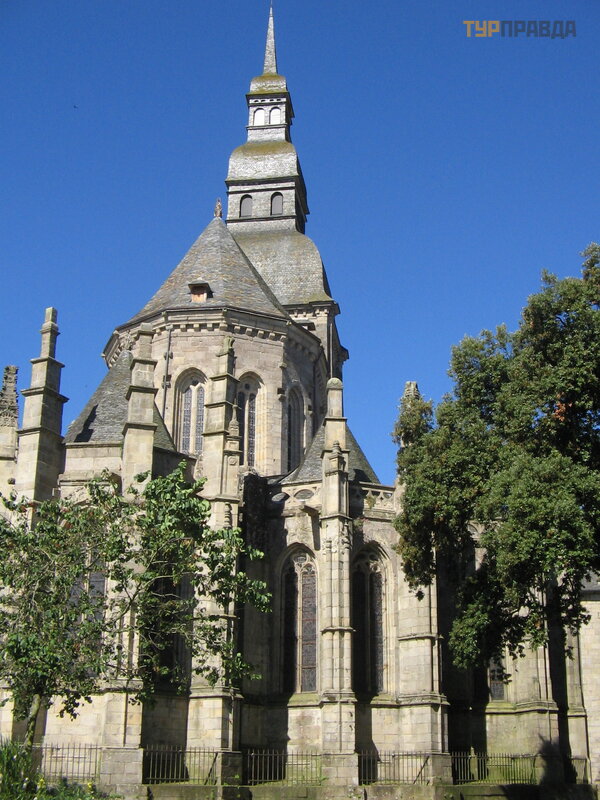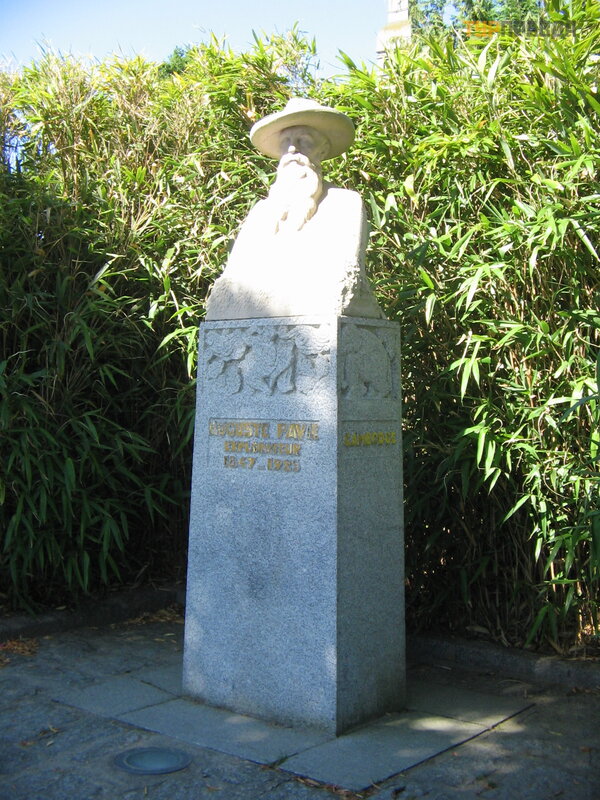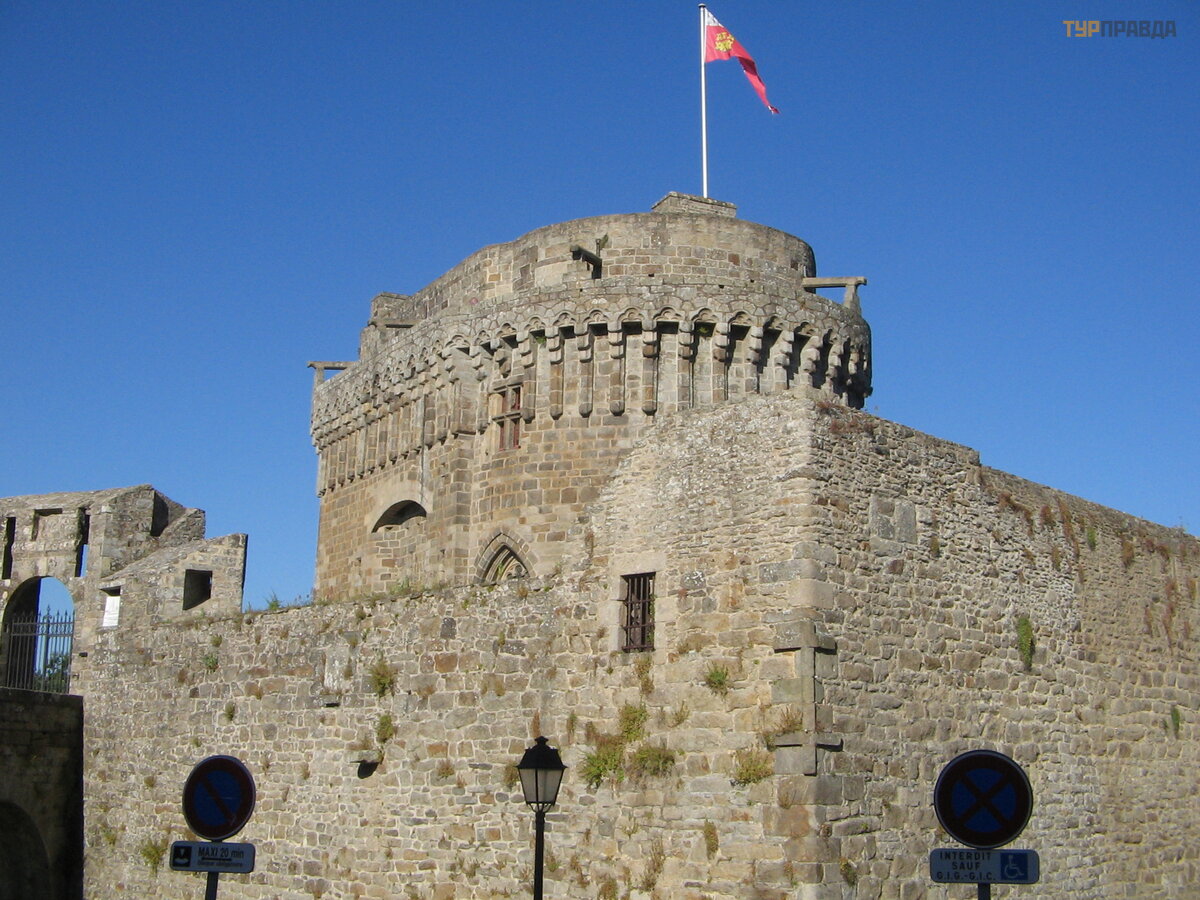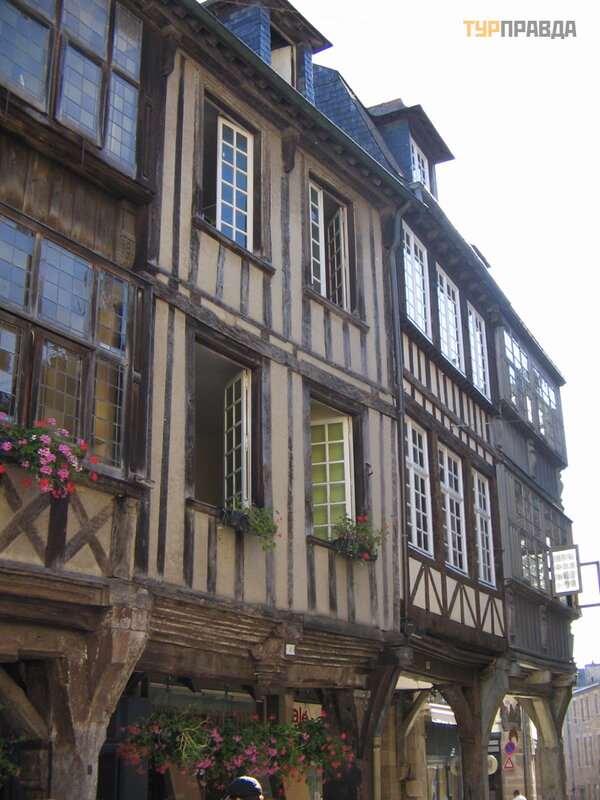City of Anna (Dinan)
From Saint-Malo we went on an excursion to Dinant. I hoped that we would spend the whole day there, finally going nowhere. Alas. We went again in a quick way, for half a day. This is not enough to wander around the city, and in shops, and sit in a cafe-restaurant, eating Breton pancakes.
Dinan is a small town. The most interesting is, of course, inside the medieval walls and next to them. The walls, 14 towers and gates are almost completely preserved.
The name of the city consists of two Celtic words meaning "hill, city" (by the way, the same root is in London) and "Anna" (the goddess-protector of the living and the dead among the Celts), very revered in Brittany. That is, Dinan is the city of Anna.
The city on the high bank of the Rance (flowing into the English Channel in Saint-Malo) arose at the place where the ford was located.
This place was the intersection of a land road dating back to Roman times through this ford (now the Caen-Brest road) and the waterway from France to the sea and back along the Rance (Brittany was not part of the French kingdom until the 16th century). In addition, this place is considered the meeting point of the "sea" Rance with the "river" Rance, i. e. , sea vessels went up the river to this place, where goods were reloaded, for which a port was built, and then a market appeared.
In the 9th century, the monks decide to settle at this ford in order to treat those passing by, to give them shelter in their wanderings. The oldest part of Dinan was down below, by the river and the ford. At the same time, downstream, the feudal lords who owned land here were building their fortress. The wooden fortress was supposed to protect against the attacks of the Saxons and Normans.
In the 11th century, a Benedictine monastery was founded here. Since that time, the official history of Dinan is considered. Then the bridge was built.
The monks received payment for crossing the river on this bridge. In 1065, William the Bastard then captured and burned the settlement, as one scene on the carpet in Bayeux tells. After that, a stone castle was laid on the hill, and the inhabitants began to move to live on the hill.
 a scene from a carpet in Bayeux (one of the lords of Dinan hands over the keys to the city to Wilhelm)
a scene from a carpet in Bayeux (one of the lords of Dinan hands over the keys to the city to Wilhelm)
One of the local lords Rivalon the Red, a member of the Crusades, swore that if he returned home, he would lay the foundation for the church. After returning, he kept his word and laid the foundation of the current Savior Cathedral (XII century).
Saviour's Cathedral
In the 13th century, under Jean I, Dinan became a ducal city, one of the favorite residences of the dukes. It enters the line of fortifications near the border. Coins are minted here, the States General (parliament) of Brittany gather.
The Duke orders the construction of fortress walls, the length of which today is about 3 kilometers. The walls showed their strength during the War of the Breton Succession between Blois and Montfort (supported by the French and English), heirs of the Breton duke Arthur II.
The besieged Dinant at this time was defended by Bertrand Du Guesclin. (I mentioned him when talking about Mont Saint-Michel, where his home was. His first wife was a native of Dinan and also a seer. He is considered a significant figure in the Hundred Years' War. ) A truce was made, Brother Du Guesclin went beyond the walls and the British killed him. A duel took place between the brother of the murdered man, Bertrand, and Canterbury in the market square, in which Bertrand won. After that, they say, shocked by the nobility of Bertrand during the duel, the British lifted the siege and left the city. So Du Guesclin won one of his victories.
Today, the former market square bears the name of Du Guesclin (there has been a monument to him since the beginning of the 20th century).
Du Guesclin was a supporter of Blois and the French in the War of the Breton Succession. Their army was defeated, Blois was killed. Montfort becomes the new Duke of Brittany, and Du Guesclin leaves to serve the French king. After his death, his body was buried in the royal tomb of Saint-Denis in Paris, recognizing his services to the kingdom (two more parts of the constable are buried in other places associated with his military campaigns). And in the north transept of the Cathedral of the Savior in Dinant, the heart of the famous constable of France is kept. There is a legend that the heart of his first wife was also buried there, and after death, their two hearts were united.
At the end of the 15th century, during the wars between Brittany and France, Dinan was besieged several times by French troops.
The last duke of Breton, Francis II, unsuccessfully defended his duchy. He had to look for allies throughout Europe, offering his daughter to anyone who would agree to speak on his side. So Anna became the bride of several European sovereigns. The result of the duke's defeat to the French neighbors was the marriage agreement of his young daughter with the transfer of Brittany to the French crown (the king was also a child). Under the terms of the marriage contract, in the event of the death of the king before his wife, she had to remarry his successor so that the duchy would not secede from France. After the death of her first husband, Anna immediately leaves for Brittany. His successor for the sake of Anne and Brittany is divorcing his wife. A year later, she marries the new king. But, entering into a second marriage, she insisted on the sole rule of Brittany.
Stained glass window depicting Anne's arrival at Dinant in Saint-Malo
Under her, Brittany, which remained autonomous, and Dinant, beloved by her, prospered. Anna called the city "the key to the shtatulk" (Brittany). At that time, the church of Saint-Malo was founded in the city, privileges were given to merchants, guilds of craftsmen, municipal police were organized, a bell bearing her name appeared on the clock tower, fairs flourished, etc.
Anne's daughter from her second marriage, Claude (wife of Francis I), passes Brittany to the French crown forever. In "gratitude" a variety of plum "renklod" is named after her. But Brittany retains at this time some sovereignty. This contributes to the further prosperity of the city. Commerce is developing, houses are being built. Some half-timbered houses and Renaissance mansions have been preserved.
During the religious wars, the lords of Dinan opposed the French king. But the townspeople decided to support Henry IV, not the Guises.
Therefore, Dinan escaped destruction, its inhabitants did not flee, as happened in other places. True, the fortress from that time becomes useless, it was abandoned for a long time.
There were several abbeys in the city before the revolution, there was the palace of the Bishop of Saint-Malo. During the revolution they were ruined. Benedictine became later a school. Chateaubriand, Surcouf, Pavi and others studied there.
In the 19th century, the famous viaduct appeared (before that, the only way to cross Rance was through the only stone medieval bridge that still exists near the port today). But its construction led to the desolation of the previously flourishing area of artisans, leading from the port up to the city. Then there is also the railway station.
Viaduct
At the beginning of the 20th century, there was a fire in the north of the old city. During World War II, the city was bombed.
Dinan becomes one of 70 French cities that have benefited from state support for cultural heritage.
The guide to Dinan recommends starting your tour of the city from the port and the old bridge (north-east of the city). I think this makes sense, because all the guests arriving for many centuries have risen from the port to the city to an almost 80-meter height along this path. Yes, and the photo from the bottom up will be wonderful. But we arrived by bus and started exploring the city from the castle (southwest), already at the top. Unfortunately, I did not see that wonderful path from the port to the city, because I was not prepared for the trip in advance. I only knew that it was necessary to go to Dinan. Therefore, I will not talk about the streets of Petit-Fort and Jerzual. Now there are souvenir shops. It is one of the two main axes of the city. The second passes by the Cathedral Square, crossing it from south to north.
After going up these streets, you need to turn left and go along a narrow lane to the square near the Saviour's Cathedral. It is a rare example of Romanesque architecture in the city. Above the entrance of the western portal are sculptural images of a lion and a bull (symbols of two of the apostles of Christ), columns of blind porticos stand on animals. The stained-glass windows of the 13th century, the stained-glass window with the evangelists of the 15th century, and the rest are modern in the small windows-loopholes. In one of the chapels there are statues of the Virgin Mary of the 15th and 16th centuries.
There used to be a cemetery on the back of the cathedral. Now this place is called the English Garden. Through it you can go to the fortress walls (eastern part).
Saviour's Cathedral (back view from the English Garden)
In one of the houses on the square near the cathedral, Auguste Pavy, an explorer of Indochina at the end of the 19th century, was born.
He studied Khmer culture, photographed a lot on the Mekong, worked as a communications engineer, organized a school for children of the nobility, was vice consul in Laos, actively participated in establishing the borders of this country with Siam and China, and maintaining peace in the region. Thanks to his efforts, the state of Laos was formed (under French influence). At the age of 37 he received the Order of the Legion of Honor. Returning to France, he wrote a multi-volume work on Indochina with the first maps of these places, supported other researchers, published Cambodian tales, and even fought in defense of elephants. A monument to him is located behind the cathedral, in the English Garden.
From the fortress tower of St. Catherine in the north you can clearly see the old bridge and port, and if you turn to the south - the viaduct (new bridge).
view of the old port from St. Catherine's Tower
In the same direction there used to be the Dominican, Benedictine monasteries and a little to the side - the monastery of Clarisse. This (eastern) part of the fortress wall is called the promenade of the Duchess Anna, with its two towers it hangs over the Rance valley at a height of 30 meters and stretches to the keep of the castle in the south-west of the city.
Castle (it houses a museum) has a rare oval shape of two fused towers. The donjon was built under Jean IV in the 14th century. Nearby is the gate of the Watchtower. The former moat under the donjon is now called Devil's Garden (western part of the walls). And nearby is the former market square, consisting of two parts with different names: Du Guesclin (with a monument to the constable) and Fields. During the revolution, there was a guillotine here, and now there is a parking lot.
From Place du Guesclin, along the streets of St. Clare and the Clock Tower, you can return to the square in front of the cathedral.
From the latter one can approach the Clock Tower through the archway. It was built in the 15th century in the center of the city. Before the revolution there was a town hall in it. And the bell was poured with the money of Queen Anne and still rings.
Walking further along Clock Street from south to north, you can reach the crossingAport (the name of the "market"). In the streets around the intersection today there are many half-timbered houses with overhanging floors. Under the ledges are covered galleries, because of which Dinan is called the "city of porticos". Not far from the crossroads is the Renaissance mansion Beaumanoir, which was at one time a monastery.
houses with covered galleries at L'apport crossroads
In the north of the city, near the Saint-Malo church, there was once a baron's castle. He, going on a crusade, made a vow, upon returning, to found a monastery.
A Franciscan monastery existed on the site of his possessions before the revolution. Then there was a college (Cordelier Square). The League-affiliated Plouer mansion is located on High Street.
 St. Malo church (rear view, from the Cordelier College)
St. Malo church (rear view, from the Cordelier College)
There was practically nothing left inside the church of Saint-Malo after the revolution. The stained glass windows are from the 19th century and tell the story of Dinan. Curious bowl with holy water, where the water breaks the demon.
Every two years, the city hosts a medieval festival of fortress walls. The next one is at the end of July 2016


